Gaps and Research Demand for Sustainability Certification and Standardisation in a Sustainable Bio-Based Economy in the EU
Abstract
1. Introduction
2. Materials and Methods
2.1. Analysis of Existing Sustainability Certification Schemes, Labels, and Initiatives in the EU Bio-Bio-Based Economy
2.2. Expert Interviews
2.3. Analysis of Existing Sustainability Standards in the EU Bio-Based Economy
3. Results
3.1. Overview on Existing Certification Frameworks
3.2. Gaps in Current Sustainability Certification Activities
- Gaps and weaknesses in criteria and indicator sets
- Harmonisation in criteria assessment and operationalisation
- Legislation and consensus for minimum criteria in all BBE sectors
- Leakage effects from EU BBE policies
- New innovative, inter-sectoral products
- EOL
- Traceability of sustainability and certificates along the value chain
3.2.1. Gaps and Weaknesses in Criteria and Indicator Sets
- Land use efficiency
- Tertiary resource efficiency (for the purpose of this paper, we followed the following categorisations: primary biomass resources as composed by plants, secondary biomass resources are related to animals/livestock production, tertiary biomass resources are related to post-consumption, post-production residues/wastes)
- Functionality (output service quality)
- (indirect) land use change GHG emissions
- SO2 equivalents
- PM10
- Risks for negative impacts on food prices and supply
- Levelised life-cycle cost (excluding subsidies, including CAPEX, OPEX)
- Bio-based content and recyclability/biodegradation
3.2.2. Harmonisation and Level Playing Field in Criteria Assessment and Operationalisation
- GHG mitigation thresholds or GHG emission calculations,
- the definition and implementation of core labour standards (e.g., based on ILO principles),
- Guarantee of no deforestation after a certain cut-off date,
- Legality of sourcing,
- Land use rights.
3.2.3. Legislation and Consensus for Minimum Criteria in All BBE Sectors
- Leakage effects (compare Section 3.2.4),
- Missing compatibility between the existing frameworks (e.g., in the sense of meta-stands, i.e., sustainability certification schemes recognising on another) for certification and consequently:
- Missing harmonisation and standardisation activities.
3.2.4. Leakage Effects from EU BBE Policies
3.2.5. Sustainability Assessment and Certification for New Innovative, Inter-Sectoral Products
- for algae or bacteria production and for
- CO2 capture (e.g., from air or power plants) and (e.g., for PtX).
3.2.6. EOL in Existing Principles and System Boundaries
3.2.7. Traceability of Sustainability and Certificates along the Value Chain
3.3. Gaps in Sustainability Standards for Bio-Based Products: General Issues and First Suggestions Derived by Experts Consultation
- Suggestions related to improving the existing EN 16751 standard (Europe’s most prominent sustainability assessment standard for bio-based products),
- Standardisation issues beyond the scope of EN 16751.
3.3.1. Suggestions Related to EN 16751
3.3.2. Standardisation Issues beyond the Scope of EN 16751
3.4. Summary of Gaps Identified and Potential Links to Future Research Acticities
4. Discussion
5. Conclusions
Author Contributions
Funding
Acknowledgments
Conflicts of Interest
Appendix A—Information on Analysed Certification Frameworks
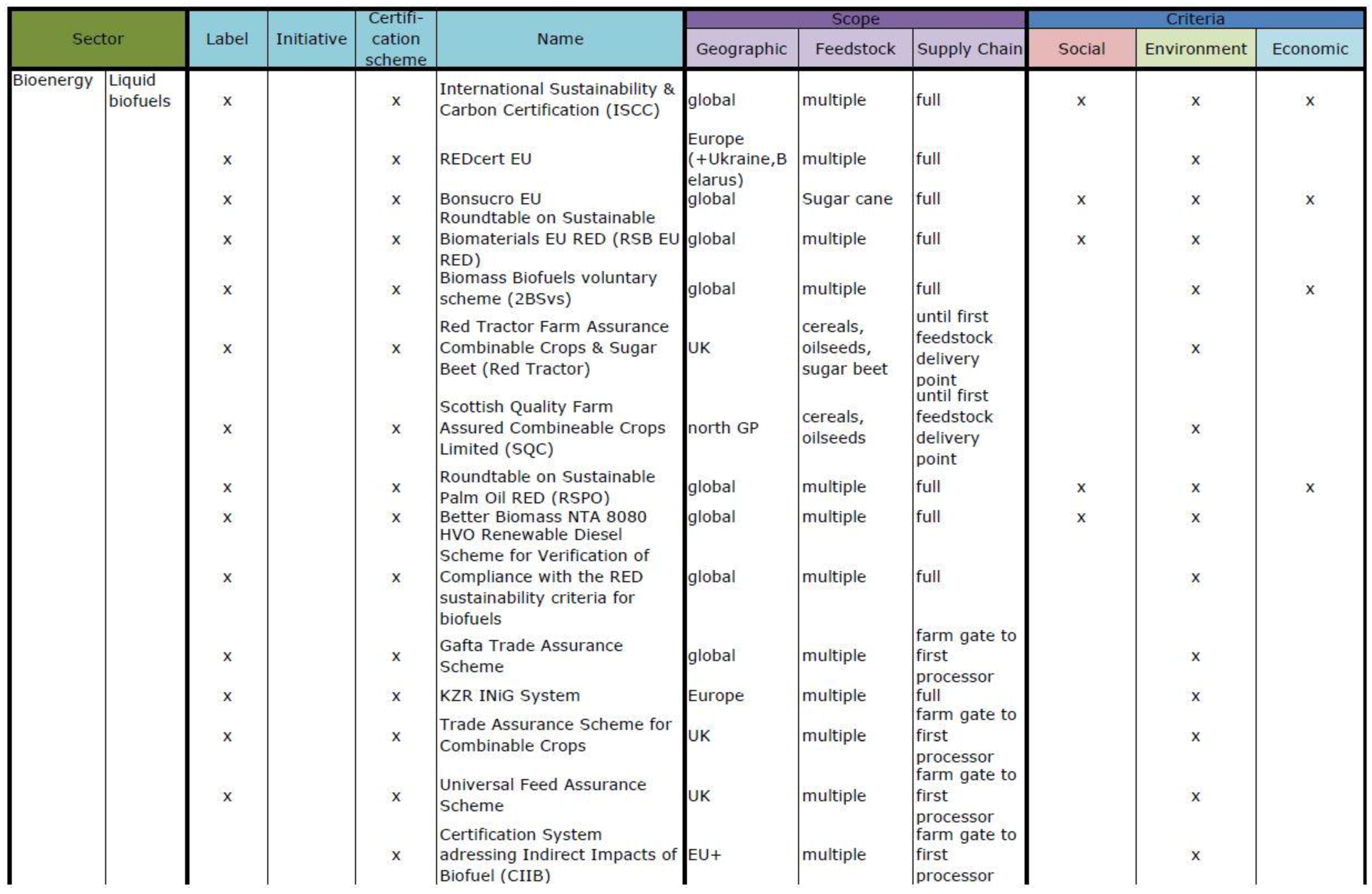
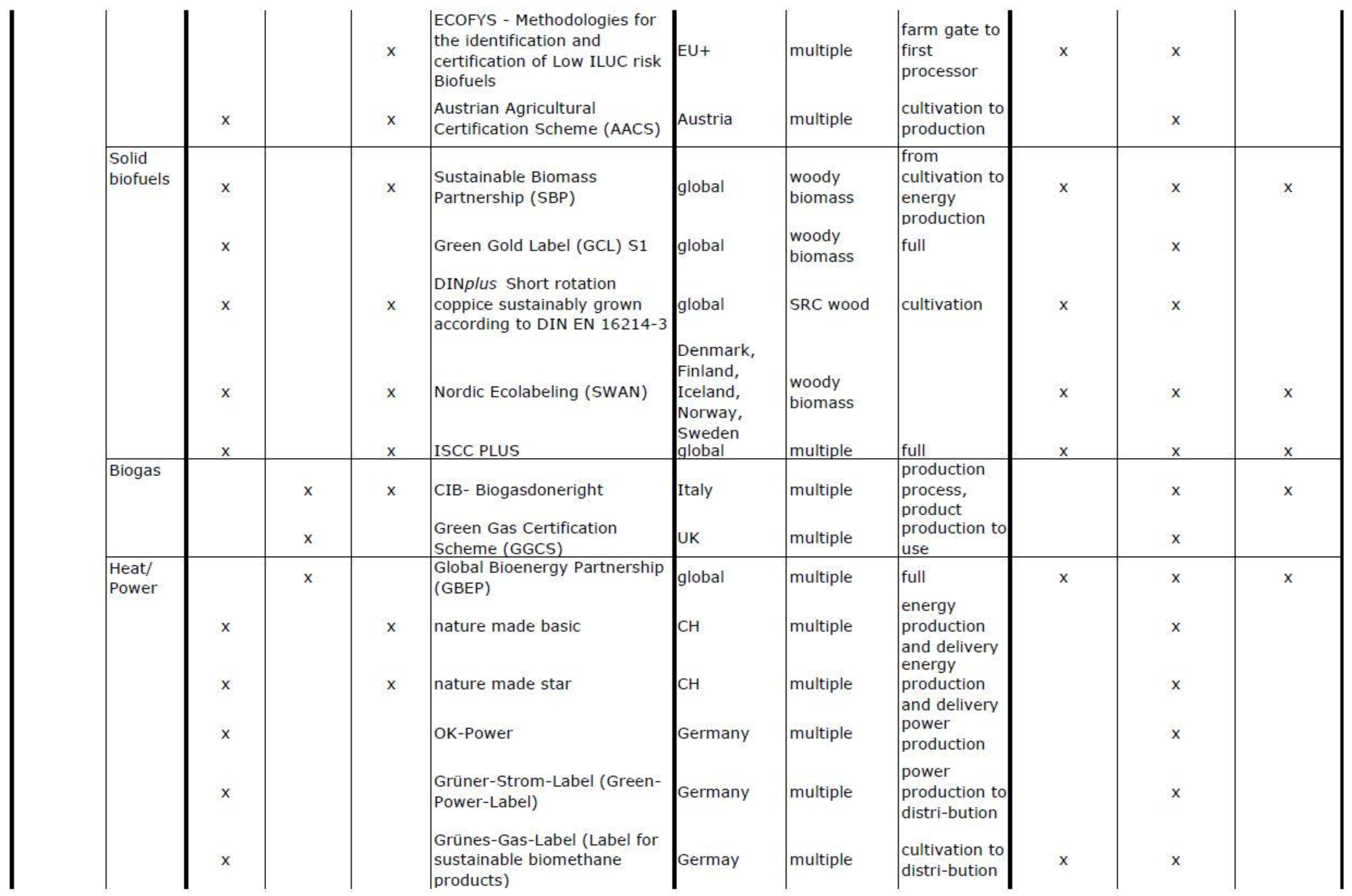
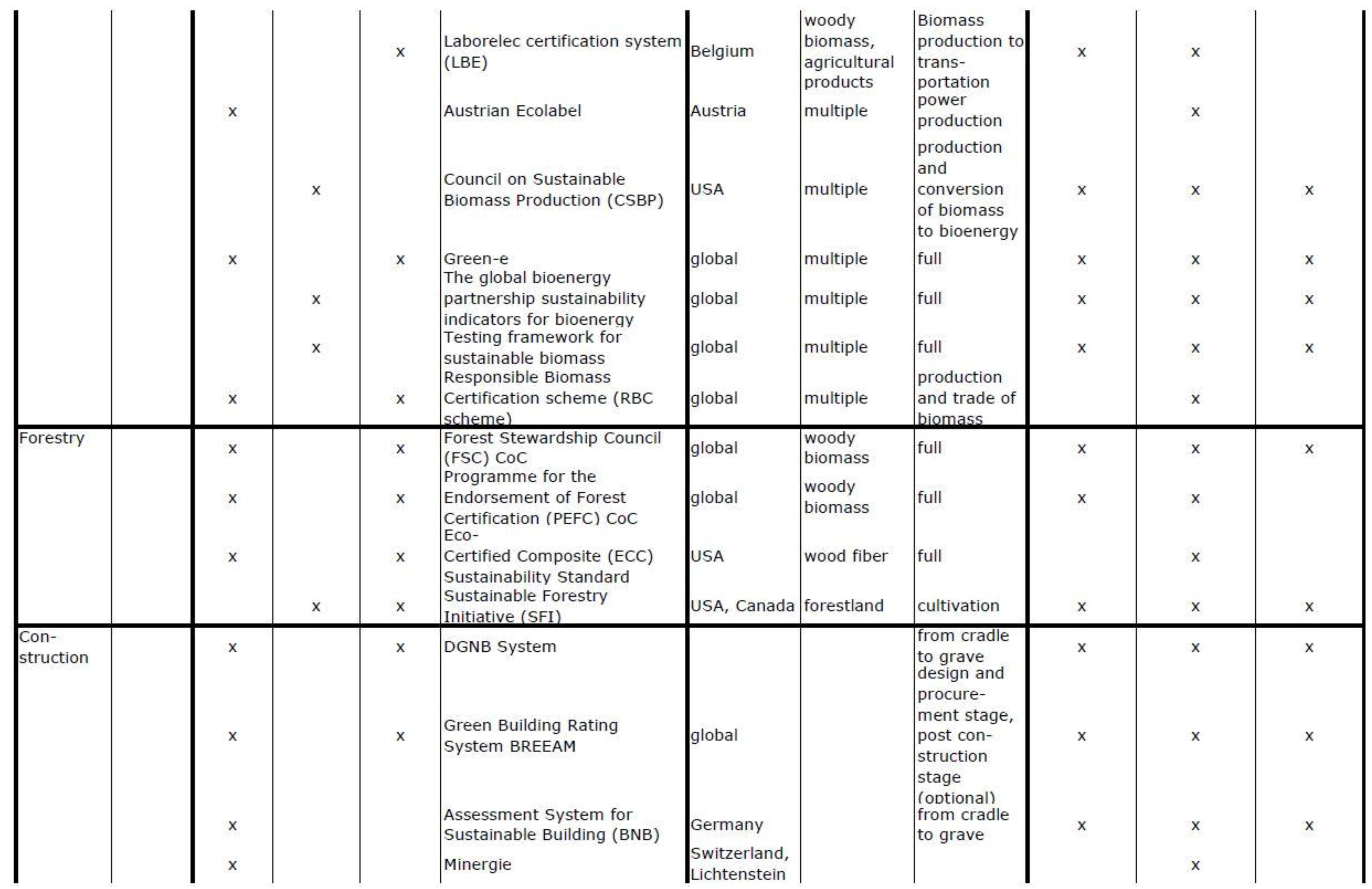
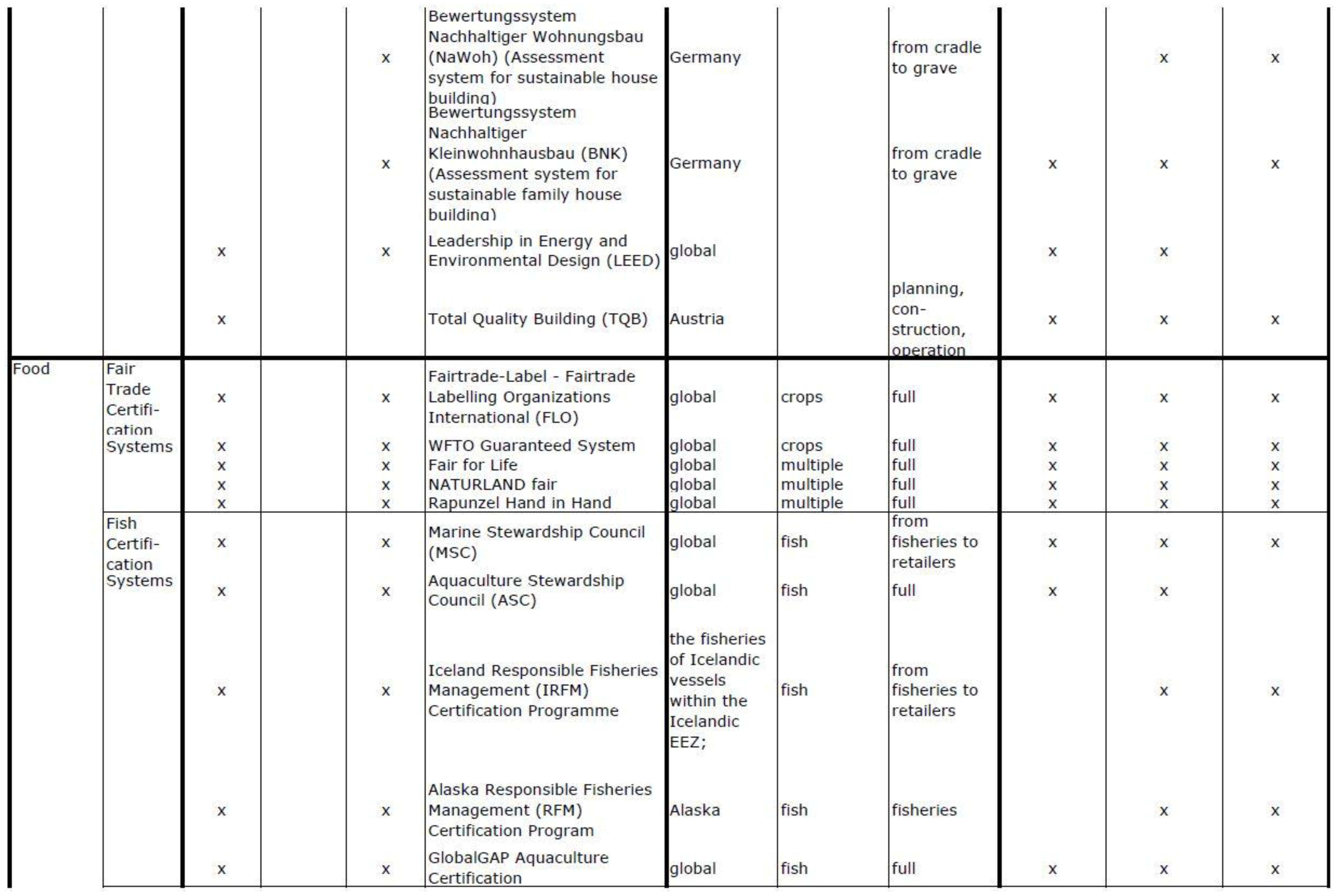
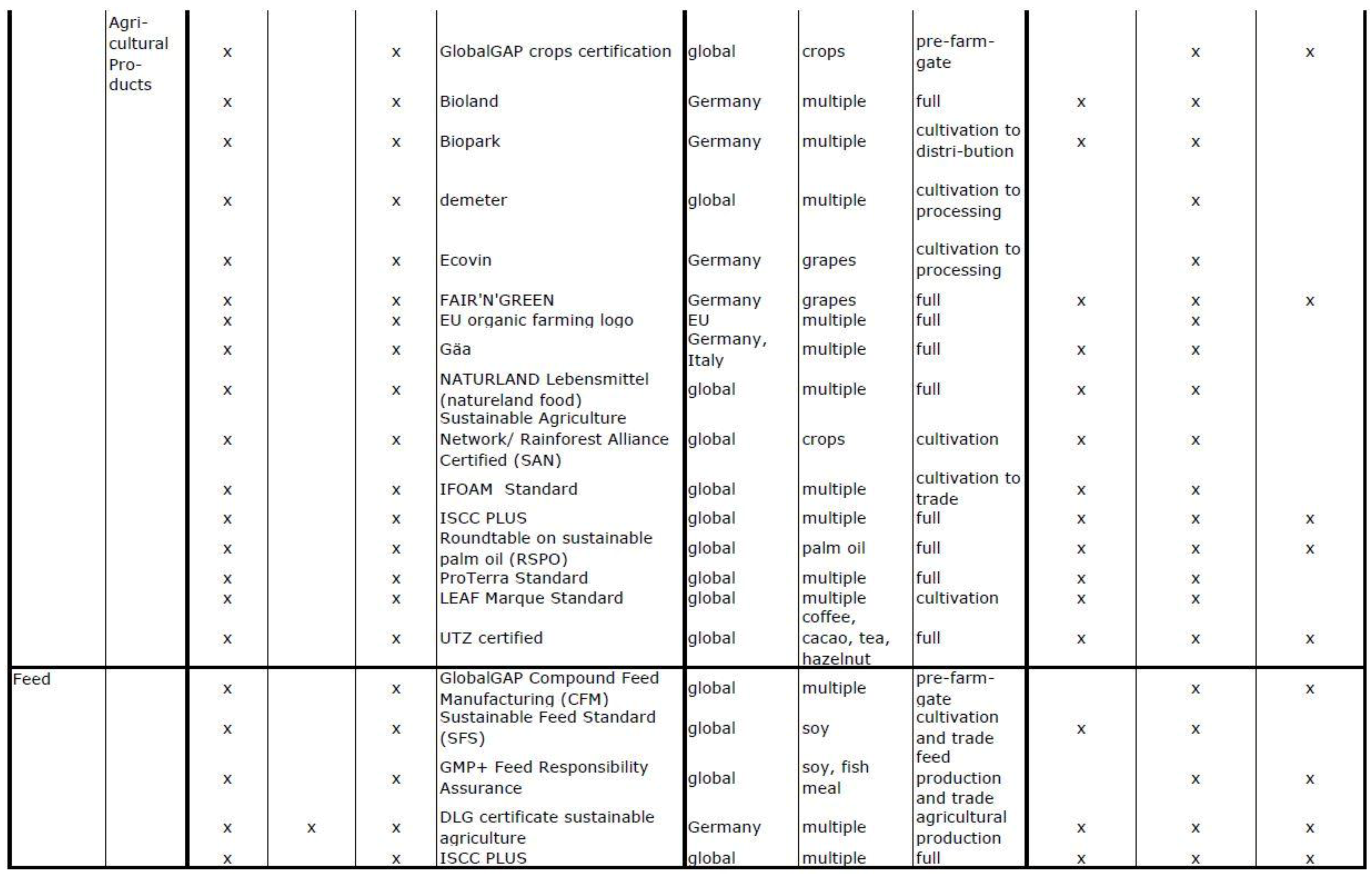
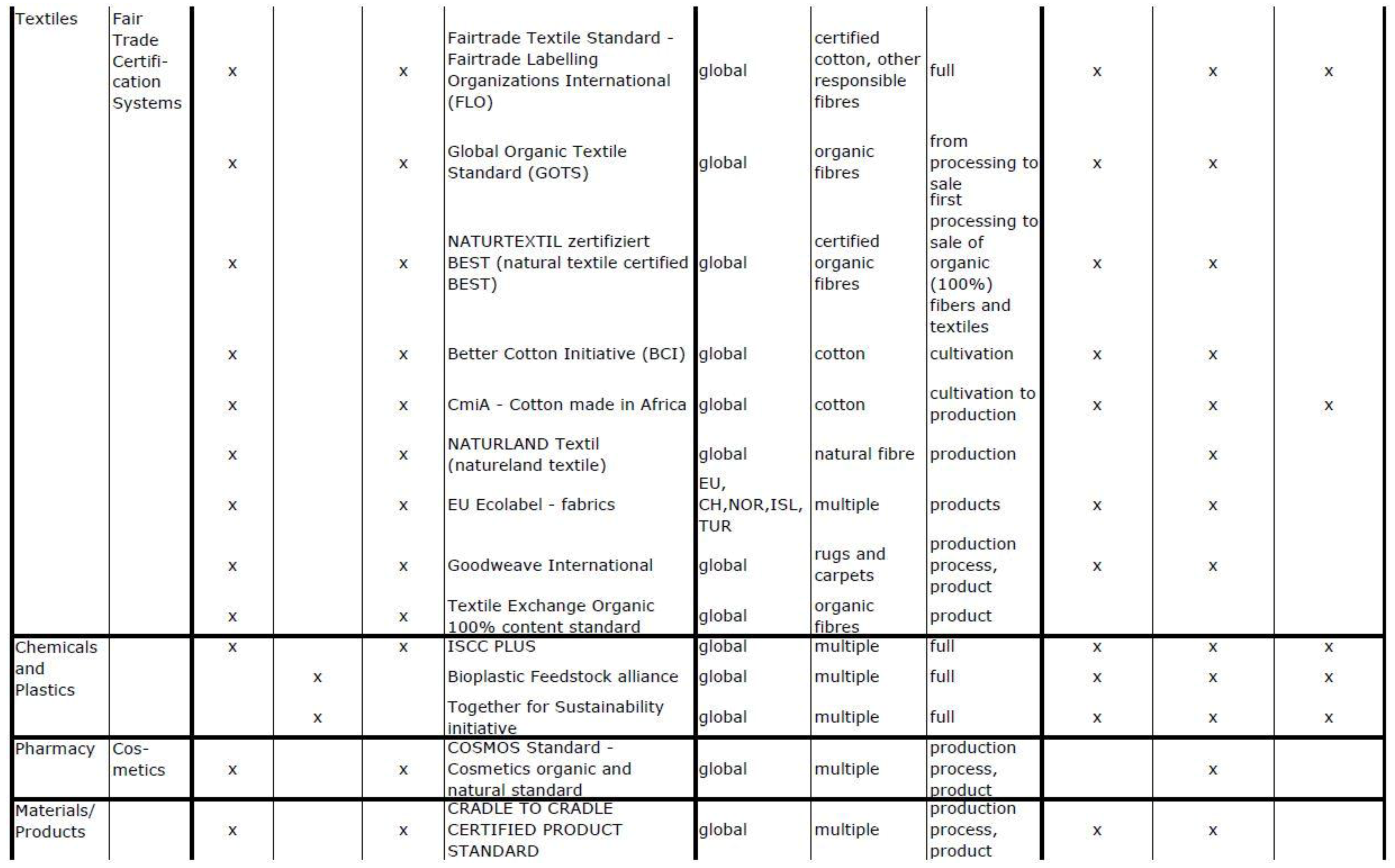

Appendix B—Interview Guide/Questionnaire
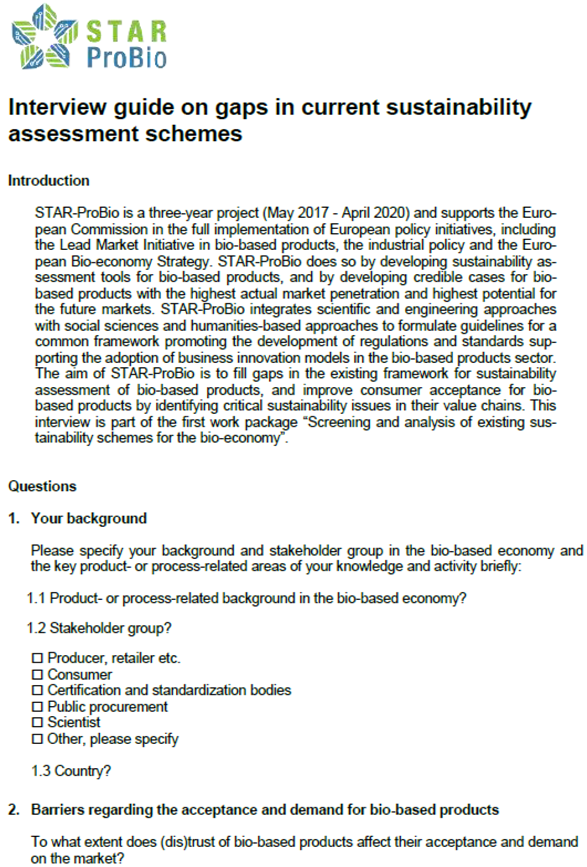



Appendix C—Identified Gaps and Corresponding Expert Interview Results
| Identified Gap | Expert Interview Answer |
|---|---|
| Assessment methods and thresholds for criteria of EN 16751, if they cannot be defined via horizontal standardisation | “Need for sustainability requirements (especially caps and thresholds) for the bio-based economy as a whole (instead of biofuels (bioenergy) only” |
| “Additional requirements and criteria should not be associated with economic burdens for operators.” | |
| “The standard EN 16571 will be revised after 5 years automatically The committee will meet again after 4–5 years and decide whether there is a need for revision” | |
| “Minimum requirement for sustainable procurement (“EU Bio-based”), for specific products (plastics…) also minimum bio-based content (“quota”) to be raised over time” |
| Identified Gap | Expert Interview Answer |
|---|---|
| Assessment methods and thresholds for ISO 13065 criteria; if necessary, by additional standards | “ISO may be the best platform to define overarching requirements and guidelines for the definition of specific criteria. ISO 13065 gives an excellent start for bioenergy which should be mainstreamed for other bio-based products.” |
| “EN 16751:2016 might need an update taking ISO 13065 into account” | |
“Need for new EU Standard similar to the RED with a regulatory framework for all supply chains dealing with biomass to ensure no-deforestation in products entering the European market, also for food, feed and chemicals
| |
| “RSB, ISCC, FSC® (if wood-based), may be considered to be frontrunner schemes, but they also should benchmark themselves against ISO 13065” | |
| “Standardization of requirements for sustainable biomass and harmonization of certification/certification systems of sustainable biomass (ISO-Standard). The approach of mandatory sustainability criteria for biofuels in EU could be extended to other bio based products/markets. E.g., packaging, food, feed.” | |
| “Increase awareness about the properties of bio-based products utilising current European standards and labelling systems help to specify and communicate the properties of bio-based products in a clear and unambiguous way, thereby contributing to a level of certainty in the market. There will continue to be an ongoing need for new standardisation and labelling (single, unifying, identifiable) to create market certainty for the bio-based sector.” |
| Identified Gap | Expert Interview Answer |
|---|---|
| Cradle-to-grave or cradle-to-cradle analyses of bio-based products | “Better traceability along entire supply chain” |
| “Demand for more and standardised LCA assessment of greenhouse gas emissions” |
| Identified Gap | Expert Interview Answer |
|---|---|
| Standardisation of iLUC and related issues | Clear demand for “criteria addressing the leakage effects from policies and regulations for the European market to other parts of the world → iLUC and carbon debt” |
| Clear demand for “criteria to address risks and leakage effects regarding to land use change, food security, etc.” |
| Identified Gap | Expert Interview Answer |
|---|---|
| Standards for the circular economy | “Consumers need more clarity on “bio-based” and “biodegradation”; more clarity on how to recycle bio-based products” |
| Demand for “standardised methods to measure circular issues” |
| Identified Gap | Expert Interview Answer |
|---|---|
| Gaps & weaknesses in criteria & indicator sets | Build on results from previous projects such as S2Biom |
| “No need/demand for new criteria. However, on the level of indicators, additional work is necessary” | |
| Demand for criteria related to “resource efficiency, bio-based content and recyclability/biodegradation” | |
| Demand for criteria related to “bio-based content of products; bio-based label such as USDA bio-preferred” |
| Identified Gap | Expert Interview Answer |
|---|---|
| Harmonisation in criteria assessment and operationalisation | Harmonisation is needed for criteria such as: “guarantee of no deforestation after a certain cut-off date, core labour standards, legality of sourcing, land use rights, GHG emissions” |
| Main barrier for more harmonisation is “the lack of a level playing field” | |
| “Existing criteria should be communicated better and be defined more precisely” | |
| “Criteria are widely available. It is more a question of the actual implementation and acceptance” | |
| “There seems to be no need for new criteria. More important to make better use of existing criteria and tools” | |
| Demand for “Better coverage of core social issues during audit. Better risk analysis” |
| Identified Gap | Expert Interview Answer |
|---|---|
| Legislation & consensus for minimum criteria in all BBE sectors | “It is less important to introduce “additional” criteria, it seems more important to mainstream sustainability requirements to all kind of biomass production. We then might need equivalent sets for production from
|
| “In contrast to schemes for bio-energy and bio-fuels, which are acknowledged by the Bio-energy Directive, schemes for bio-based products are entirely voluntary. There is no legal requirement to prove that bio-based products are sustainable” | |
| “Sustainability requirements (especially caps and thresholds) should be introduced for the bio-based economy as a whole (instead of biofuels (bioenergy) only)” | |
“New EU Standard similar to the RED with a regulatory framework for all supply chains dealing with biomass to ensure no-deforestation in products entering the European market, also for food, feed and chemicals
| |
| “We need sustainability criteria for ALL types of biomass cultivation and also for food and feed. Equal changes and equal burdens for all of them.” | |
“Generally, all schemes can be enhanced through new criteria that are reasonable to increase sustainable products
| |
| Need for “Standardization of requirements for sustainable biomass and harmonization of certification/certification systems of sustainable biomass (ISO-Standard). The approach of mandatory sustainability criteria for biofuels in EU could be extended to other bio based products/markets. E.g., packaging, food, feed.” | |
| “Develop minimum consensus for a sustainability criteria set for the bioeconomy” |
| Identified Gap | Expert Interview Answer |
|---|---|
| Leakage effects from EU BBE policies | Demand for “criteria addressing the leakage effects from policies and regulations for the European market to other parts of the world → iLUC and carbon debt” |
| Demand for “bottom up approaches for product certification based on risk based criteria” | |
| “Leakage effects have to be addressed by both policies and certification” |
| Identified Gap | Expert Interview Answer |
|---|---|
| New innovative, inter-sectoral products | “For algae or bacteria production there are nearly no blueprints for sustainability assessments” |
| No blueprints and frameworks for “CO2 from air by PtX” |
| Identified Gap | Expert Interview Answer |
|---|---|
| End-of-Life (EOL) | “Consumers need more clarity on “bio-based” and “biodegradation”; more clarity on how to recycle bio-based products” |
| “Capture downstream assessment characteristics (manufacture and so on) right up to the end of life options” | |
| “Policy considerations for specific minimum requirements (bio-based content, degradability) especially for plastics” |
| Identified Gap | Expert Interview Answer |
|---|---|
| Traceability of sustainability and certificates along the value chain | Demand for “better traceability of sustainability information along entire supply chain, performance also compared to non-bio” |
| Demand for “Performance indicators; features related to health, origin of biomass (made in.)” | |
| “Demand for criteria to express the value of local small value chains, closed nutrient cycles, etc.” | |
| “Use of databases transferring sustainability characteristics across supply chain” | |
| “Use of objective analysis, e.g., remote sensing tool as proof of no deforestation and transfer of information across supply chain with better traceability tools” | |
| Demand for an “obligatory database to be publicly available for all assessment/certification systems with detailed information about all granted certificates and holders” |
Appendix D—Standards Landscape—Selected Examples
| Acronym | Title | Sust | Envi | Soci | Econ |
|---|---|---|---|---|---|
| ISO 26000 | Guidance on social responsibility | x | x | x | x |
| NTA 8080 | Sustainability criteria for biomass for energy purposes | x | x | x | x |
| ISO 1404X | Environmental management–Life cycle assessment (Series) | - | x | - | - |
| VDI 4431 ISO 14064 | GHG–Part 1: Specification with guidance at the organization level for quantification and reporting of GHG emissions and removals | - | x | x | - |
| CEN/TR 15932 | Plastics–Recommendation for... characterisation of biopolymers & ~plastics | - | x | - | - |
| ASTM D 7075 | Practice for Evaluating and Reporting Environ. Performance of BBP | x | x | - | - |
| ASTM D6852 | Environmental Profile of Materials and Products | - | x | - | - |
| PAS 2050 | Specification for the assessment of the life cycle | - | x | - | - |
| BP X30-323 | General principles for an environ. communication | - | x | - | - |
| ISO 15380 | Lubricants, industrial oils and related products … | - | x | - | - |
| SS 155434 | Hydraulic fluids–Requirements and test methods | - | x | - | - |
| SS 155470 | Lubricants, industrial oil and related products … | - | x | - | - |
| NF U 52-001 | Biodegradable materials–Mulching products–Req. & test methods | - | x | - | - |
| Acronym | Topic | Sust | Envi | Soci | Econ |
|---|---|---|---|---|---|
| Selected additional standards based on STAR-ProBio analyses | |||||
| EN 16751 | Bio-based products–Sustainability criteria | x | x | x | x |
| EN 16760 | Bio-based products–Life Cycle Assessment | x | x | x | - |
| CEN/TR 16957 | Bio-based products–Guidelines for LCI for the EoL phase | x | x | - | - |
| Standards in related areas | |||||
| ISO 13065 | Sustainability criteria for bioenergy | x | x | x | x |
| EN 16214-3 and 4 | Sust. criteria for the production of biofuels & bioliquids for energy appli-cations–Principles, criteria, indicators …- 3: Biodiversity & environmental aspects …; 4: Calc. methods of the GHG emission balance using a LCA approach | x | x | ||
| ISO/FDIS 34101-2 | Sustainable and traceable cocoa beans–Part 2: Req. for performance (related to econ., social, and environ. aspects) | x | x | x | x |
| ASTM E 3066a | Standard Practice for Evaluating Relative Sustainability Involving Energy or Chemicals from Biomass | x | x | x | x |
References
- National Policy Strategy on Bioeconomy: Renewable Resources and Biotechnological Processes as a Basis for Food, Industry and Energy, 2014th ed.; Federal Ministry of Food and Agriculture: Berlin, Germany, 2014.
- Delbrück, S. Future Opportunities and Developments in the Bioeconomy—A Global Expert Survey; German Bioeconomy Council: Berlin, Germany, 2018. [Google Scholar]
- Staffas, L.; Gustavsson, M.; McCormick, K. Strategies and Policies for the Bioeconomy and Bio-Based Economy: An Analysis of Official National Approaches. Sustainability 2013, 5, 2751–2769. [Google Scholar] [CrossRef]
- European Commission. Bio-Based Economy for Europe: State of Play and Future Potential Europe; Report on the European Commission’s Public on-line Consultation; Publications Office of the European Union: Luxembourg, 2011. [Google Scholar]
- Giuntoli, J.; Cristobal, J.; Parisi, C.; Ferrari, E.; Marelli, L.; Torres de Matos, C.; Gomez Barbero, M.; Rodriguez Cerezo, E. Bioeconomy Report 2016; JRC Scientific and Policy Report; Publications Office of the European Union: Luxembourg, 2017. [Google Scholar]
- Du Pisani, J.A. Sustainable development—Historical roots of the concept. Environ. Sci. 2006, 3, 83–96. [Google Scholar] [CrossRef]
- Wiersum, K.F. 200 years of sustainability in forestry: Lessons from history. Environ. Manag. 1995, 19, 321–329. [Google Scholar] [CrossRef]
- Komives, K.; Jackson, A. Introduction to Voluntary Sustainability Standard Systems. In Voluntary Standard Systems; Schmitz-Hoffmann, C., Schmidt, M., Hansmann, B., Palekhov, D., Eds.; Springer: Berlin/Heidelberg, Germany, 2014; pp. 3–19. [Google Scholar]
- FSC International. FSC Database. Available online: https://ic.fsc.org/en (accessed on 25 April 2018).
- Kraxner, F.; Schepaschenko, D.; Fuss, S.; Lunnan, A.; Kindermann, G.; Aoki, K.; Dürauer, M.; Shvidenko, A.; See, L. Mapping certified forests for sustainable management—A global tool for information improvement through participatory and collaborative mapping. For. Policy Econ. 2017, 83, 10–18. [Google Scholar] [CrossRef]
- Directive (EU) 2015/1513 of the European Parliament and of the Council of 9 September 2015 Amending Directive 98/70/EC Relating to the Quality of Petrol and Diesel Fuels and Amending Directive 2009/28/EC on the Promotion of the Use of Energy from Renewable Sources; European Union: Brussels, Belgium, 2015.
- Mitchel, D. A Note on Rising Food Prices; The World Bank: Washington, DC, USA, 2008. [Google Scholar]
- Searchinger, T.; Heimlich, R.; Houghton, R.A.; Dong, F.; Elobeid, A.; Fabiosa, J.; Tokgoz, S.; Hayes, D.; Yu, T.-H. Use of U.S. croplands for biofuels increases greenhouse gases through emissions from land-use change. Science 2008, 319, 1238–1240. [Google Scholar] [CrossRef] [PubMed]
- Lin, J. Governing Biofuels: A Principal-Agent Analysis of the European Union Biofuels Certification Regime and the Clean Development Mechanism. J. Environ. Law 2012, 24, 43–73. [Google Scholar] [CrossRef]
- Proposal for a Directive of the European Parliament and of the Council on the Promotion of the Use of Energy from Renewable Sources (Recast). COM/2016/0767 Final/2–2016/0382 (COD); European Commission: Brussels, Belgium, 2016.
- van Dam, J.; Junginger, M.; Faaij, A.; Jürgens, I.; Best, G.; Fritsche, U. Overview of recent developments in sustainable biomass certification. Biomass Bioenergy 2008, 32, 749–780. [Google Scholar] [CrossRef]
- Ladu, L.; Blind, K. Overview of policies, standards and certifications supporting the European bio-based economy. Curr. Opin. Green Sustain. Chem. 2017, 8, 30–35. [Google Scholar] [CrossRef]
- Blind, K.; Petersen, S.S.; Riillo, C.A.F. The impact of standards and regulation on innovation in uncertain markets. Res. Policy 2017, 46, 249–264. [Google Scholar] [CrossRef]
- M/491 Mandate Addressed to CEN, CENELEC and ETSI for the Development of European Standards and Technical Specifications and/or Technical Reports for Bio-Surfactants and Bio-Solvents in Relation to Bio-Based Product Aspects; European Commission: Brussels, Belgium, 2011.
- M/492 Mandate Addressed to CEN, CENELEC and ETSI for the Development of Horizontal European Standards and other Standardisation Deliverables for Bio-Based Products; European Commission: Brussels, Belgium, 2011.
- Mandate 53/2008 (CEN M/430) M/430 Mandate Addressed to CEN for the Development of European Standards and CEN Workshop Agreements for Bio-Polymers and Bio-Lubricants in Relation to Bio-Based Product Aspects; European Commission: Brussels, Belgium, 2008.
- Directive 2009/30/EC of the European Parliament and of the Council of 23 April 2009 Amending Directive 98/70/EC as Regards the Specification of Petrol, Diesel and Gas-Oil and Introducing a Mechanism to Monitor and Reduce Greenhouse Gas Emissions and Amending Council Directive 1999/32/EC as Regards the Specification of Fuel Used by Inland Waterway Vessels and Repealing Directive 93/12/EEC: FQD; European Commission: Brussels, Belgium, 2009.
- Lewandowski, I. Securing a sustainable biomass supply in a growing bioeconomy. Glob. Food Secur. 2015, 6, 34–42. [Google Scholar] [CrossRef]
- Majer, S.; Moosmann, D.; Sumfleth, B. STAR-ProBio Criteria and Indicator Database. 2017. Available online: http://www.star-probio.eu/wp-content/uploads/2017/12/Star-ProBio_certification_criteria.xlsx (accessed on 15 March 2018).
- Strauss, A.L.; Corbin, J.M. Grounded Theory: Grundlagen Qualitativer Sozialforschung; Beltz: Weinheim, Germany, 2010. [Google Scholar]
- STAR-ProBio. STAR-ProBio Deliverable D7.1. Examination of Existing ILUC Approaches and Their Application to Bio-Based Materials; Unitelma Sapienza University: Rome, Italy, 2018. [Google Scholar]
- DIN. DIN ISO 13065 Nachhaltigkeitskriterien für Bioenergie; DIN: Berlin, Germany, 2017. [Google Scholar]
- D18 Committee. Guide for Set of Data Elements to Describe a Groundwater Site; Part One—Additional Identification Descriptors; ASTM International: West Conshohocken, PA, USA, 2004. [Google Scholar]
- D18 Committee. Guide for Using the Seismic Refraction Method for Subsurface Investigation; ASTM International: West Conshohocken, PA, USA, 2011. [Google Scholar]
- D18 Committee. Guide for Selection of Methods for Estimating Soil Loss by Erosion; ASTM International: West Conshohocken, PA, USA, 2012. [Google Scholar]
- D20 Committee. Guide for Exposing and Testing Plastics that Degrade in the Environment by a Combination of Oxidation and Biodegradation; ASTM International: West Conshohocken, PA, USA, 2018. [Google Scholar]
- Iriarte, L. Consistent Cross-Sectoral Sustainability Criteria & Indicators; European Commission: Brussels, Belgium, 2017. [Google Scholar]
- Iriarte, L. Benchmark and Gap Analysis of Criteria and Indicators (C&I) for Legislation, Regulations and Voluntary Schemes at International Level and in Selected EU Member States: Main Report; European Commission: Brussels, Belgium, 2015. [Google Scholar]
- Buchholz, T.; Luzadis, V.A.; Volk, T.A. Sustainability criteria for bioenergy systems: Results from an expert survey. J. Clean. Prod. 2009, 17, S86–S98. [Google Scholar] [CrossRef]
- Pavlovskaia, E. Sustainability criteria: Their indicators, control, and monitoring (with examples from the biofuel sector). Environ. Sci. Eur. 2014, 26, 17. [Google Scholar] [CrossRef] [PubMed]
- FAO. FAO’s BEFS Approach at a Glance. Available online: http://www.fao.org/3/a-h0011e.pdf (accessed on 20 December 2017).
- Majer, S.; Gröngröft, A.; Drache, C.; Braune, M.; Meisel, K.; Müller-Langer, F.; Naumann, K.; Oehmichen, K. Technische und Methodische Grundlagen der THG-Bilanzierung von Biodiesel, 1st ed.; DBFZ: Leipzig, Germany, 2015. [Google Scholar]
- Naumann, K.; Oehmichen, K.; Remmele, E.; Thuneke, K.; Schröder, J.; Zeymer, M.; Zech, K.; Müller-Langer, F. Monitoring Biokraftstoffsektor, 3rd ed.; DBFZ: Leipzig, Germany, 2016. [Google Scholar]
- Oehmichen, K.; Naumann, K.; Drache, C.; Postel, J.; Braune, M.; Gröngröft, A.; Majer, S.; Meisel, K.; Müller-Langer, F. Technische und Methodische Grundlagen der THG-Bilanzierung von Biomethan, 1st ed.; DBFZ: Leipzig, Germany, 2015. [Google Scholar]
- Bentsen, N.S. Carbon debt and payback time—Lost in the forest? Renew. Sustain. Energy Rev. 2017, 73, 1211–1217. [Google Scholar] [CrossRef]
- Bovari, E.; Lecuyer, O.; Mc Isaac, F. Debt and damages: What are the chances of staying under the 2 °C warming threshold? Int. Econ. 2018. [Google Scholar] [CrossRef]
- Finkbeiner, M. Indirect land use change—Help beyond the hype? Biomass Bioenergy 2014, 62, 218–221. [Google Scholar] [CrossRef]
- Laborde, D. Assessing the Land Use Change Consequences of European Biofuel Policies: Final Report; IFPRI: Washington, DC, USA, 2011. [Google Scholar]
- Mohr, A.; Beuchelt, T.; Schneider, R.; Virchow, D. Food security criteria for voluntary biomass sustainability standards and certifications. Biomass Bioenergy 2016, 89, 133–145. [Google Scholar] [CrossRef]
- Mohr, A.; Beuchelt, T.; Schneider, R.; Virchow, D. A Rights-Based Food Security Principle for Biomass Sustainability Standards and Certification Systems; ZEF: Bonn, Germany, 2015. [Google Scholar]
- Peters, D. Methodologies for the Identification and Certification of Low ILUC Risk Biofuels; Wageningen University & Research: Wageningen, The Netherlands, 2016. [Google Scholar]
- Roundtable on Sustainable Biomaterials. RSB Low iLUC Risk Biomass Criteria and Compliance Indicators, 4th ed.; Roundtable on Sustainable Biomaterials: Berlin, Germany, 2015. [Google Scholar]
- Marazza, D.; Merloni, E.; Compagnoni, L. Examination of Existing iLUC Approaches and Application to Bio-Based Materials: Star-ProBio Deliverable 7.1; European Commission: Bologna, Italy, 2018. [Google Scholar]
- Ahlgren, S.; Di Lucia, L. Indirect land use changes of biofuel production—A review of modelling efforts and policy developments in the European Union. Biotechnol. Biofuels 2014, 7, 35. [Google Scholar] [CrossRef] [PubMed]
- Scarlat, N.; Dallemand, J.-F.; Monforti-Ferrario, F.; Nita, V. The role of biomass and bioenergy in a future bioeconomy: Policies and facts. Environ. Dev. 2015, 15, 3–34. [Google Scholar] [CrossRef]
- Van Lancker, J.; Wauters, E.; van Huylenbroeck, G. Managing innovation in the bioeconomy: An open innovation perspective. Biomass Bioenergy 2016, 90, 60–69. [Google Scholar] [CrossRef]
- Selbmann, K.; Pforte, L. Evaluation of Ecological Criteria of Biofuel Certification in Germany. Sustainability 2016, 8, 936. [Google Scholar] [CrossRef]
- CEN/TC 411 Bio-Based Products—Biobasedeconomy. Available online: http://www.biobasedeconomy.eu/centc-411-bio-based-products/ (accessed on 29 June 2018).
- IEC—SMB: Standardization Management Board > Technical Advisory Committees. Available online: http://www.iec.ch/dyn/www/f?p=103:59:0::FSP_ORG_ID,FSP_LANG_ID:3228,25 (accessed on 29 June 2018).
- Sherwood, J.; de Bruyn, M.; Constantinou, A.; Moity, L.; McElroy, C.R.; Farmer, T.J.; Duncan, T.; Raverty, W.; Hunt, A.J.; Clark, J.H. Dihydrolevoglucosenone (Cyrene) as a bio-based alternative for dipolar aprotic solvents. Chem. Commun. (Camb. Engl.) 2014, 50, 9650–9652. [Google Scholar] [CrossRef] [PubMed]
- Carus, M.; Dammer, L.; Puente, Á.; Raschka, A.; Arendt, O. Bio-Based Drop-In, Smart Drop-In and Dedicated Chemicals; Nova-Institut für Politische und Ökologische Innovation GmbH: Hürth, Germany, 2017. [Google Scholar]
- Communication from the Commission to the European Parliament, the Council, the European Economic and Social Committee and the Committee of the Regions. Closing the Loop—An EU Action Plan for the Circular Economy: COM(2015) 614 Final; European Commission: Brussels, Belgium, 2015.
- nova-Institut GmbH. Bio-Based Polymers Worldwide: Ongoing Growth Despite Difficult Market Environment—Bio-Based News—The Portal for Bio-Based Economy & Industrial Biotechnology. 2018. Available online: http://news.bio-based.eu/bio-based-polymers-worldwide-ongoing-growth-despite-difficult-market-environment/ (accessed on 27 April 2018).
- Grand Review Research. Biolubricants Market Size to Reach $2.92 Billion by 2024. Available online: https://www.grandviewresearch.com/press-release/bio-lubricants-market (accessed on 27 April 2018).

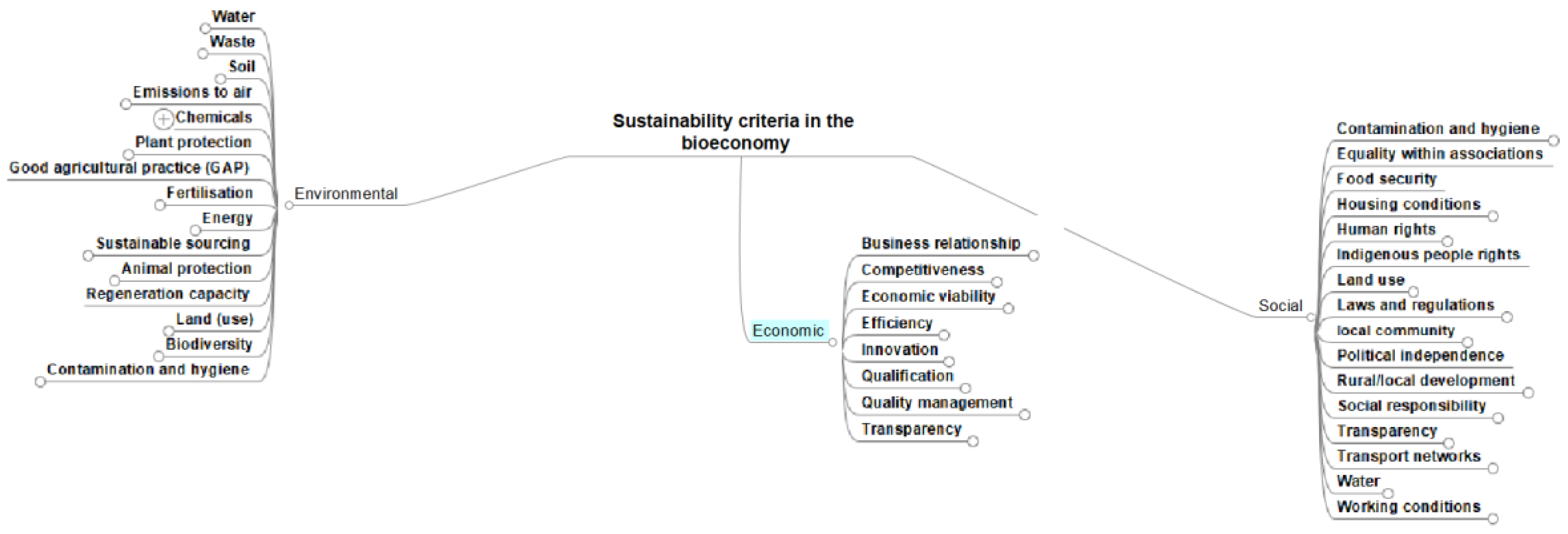
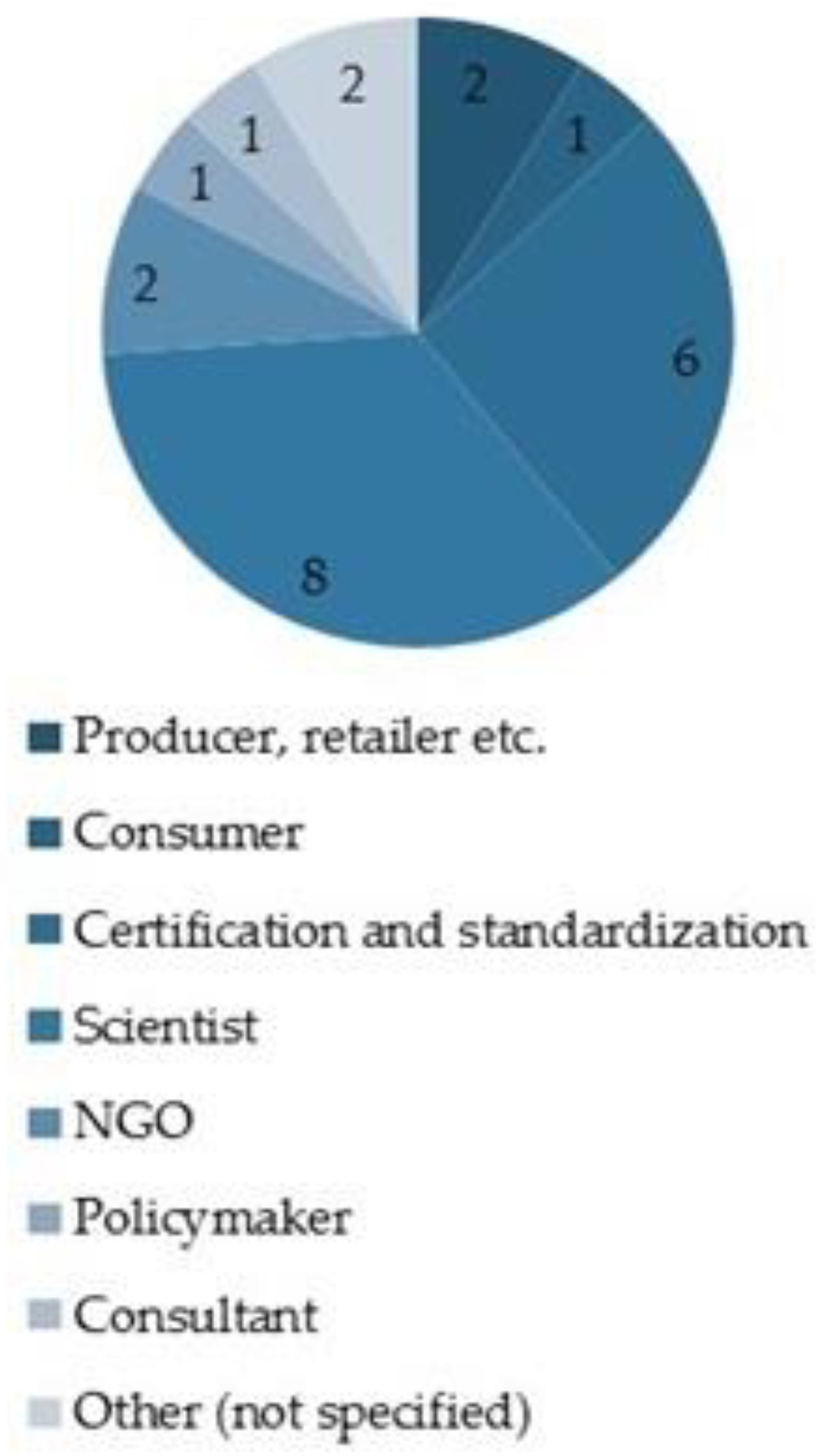
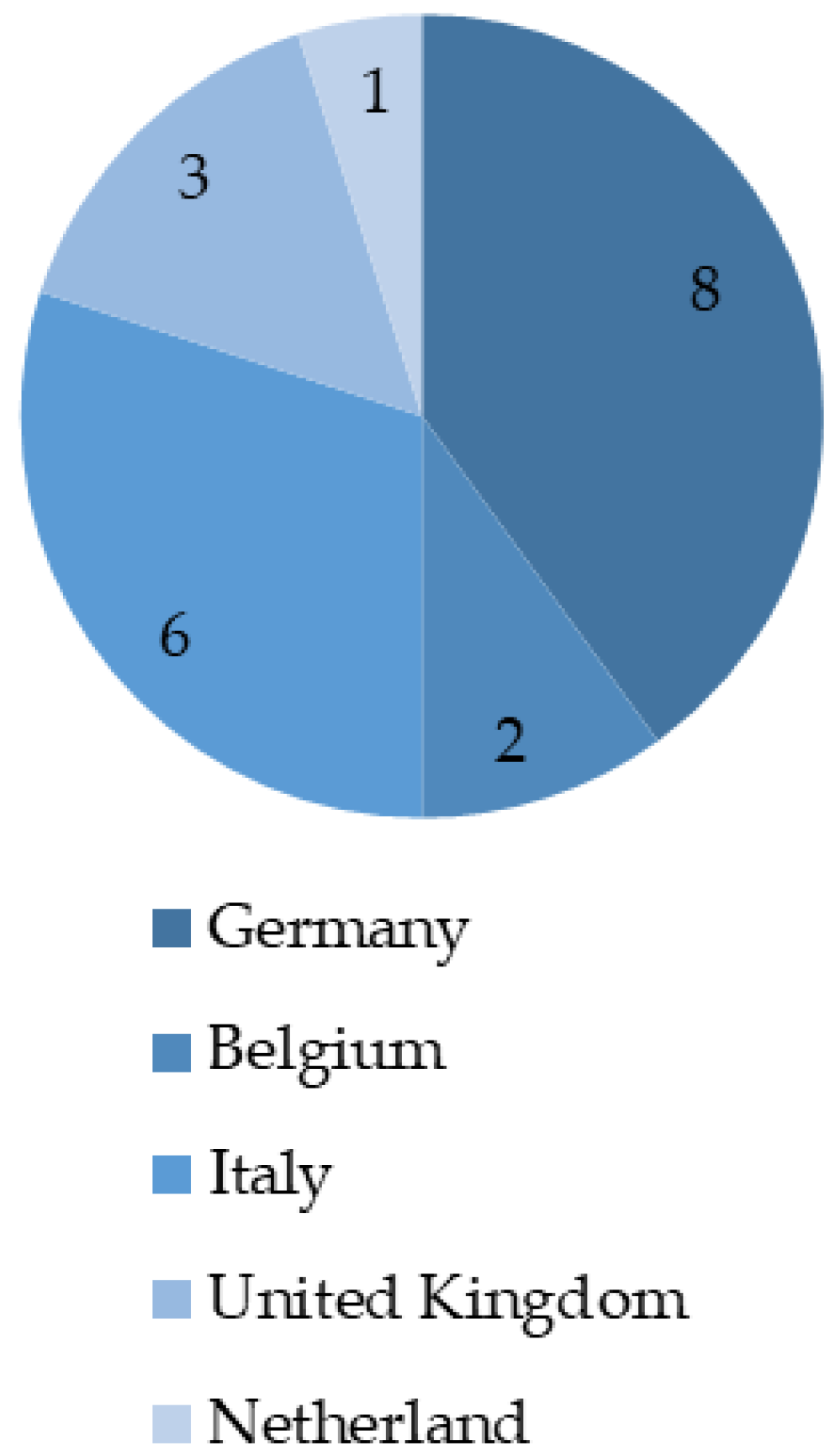
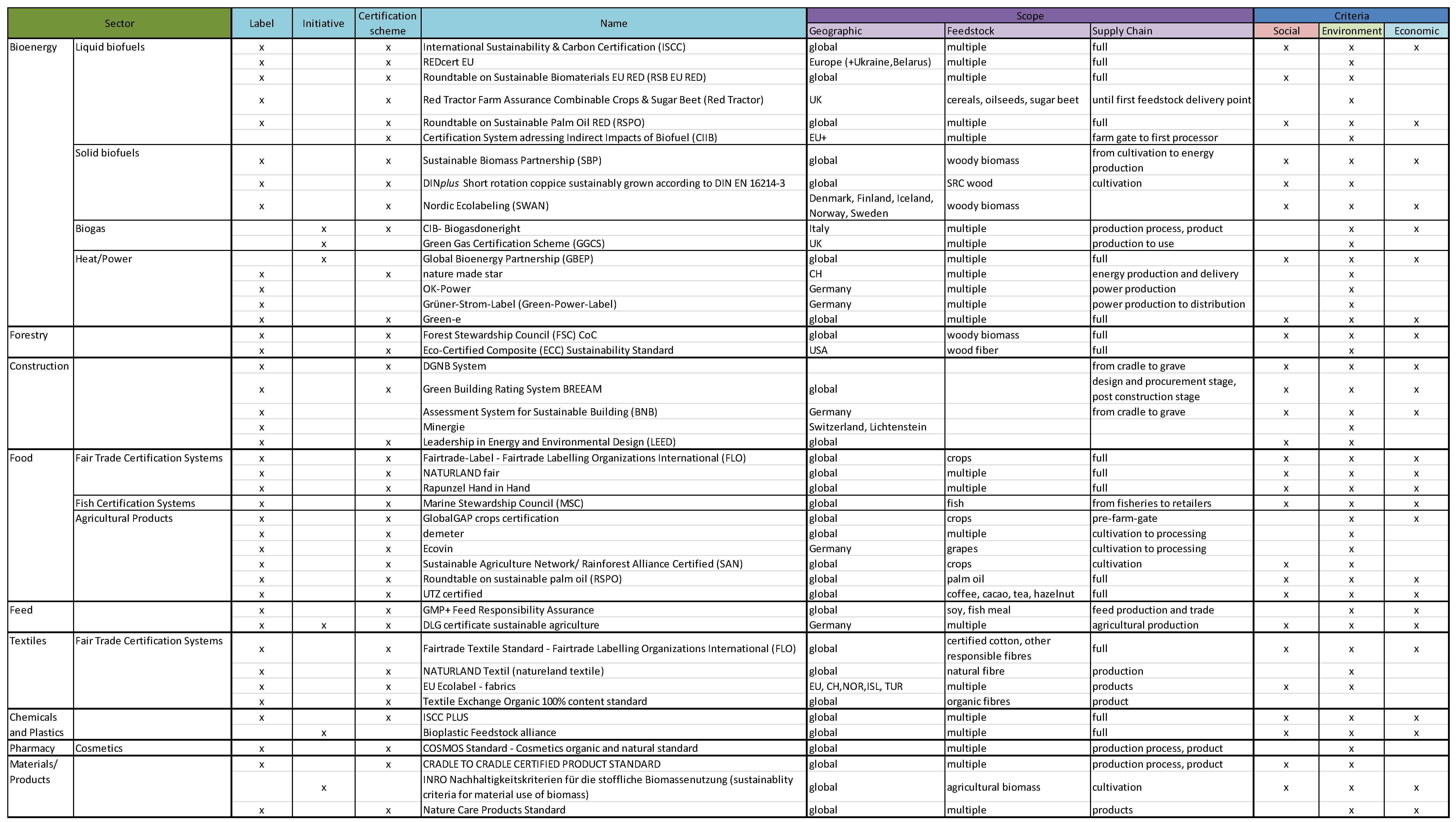
| Framework | Definition |
|---|---|
| Labels | Labels communicate the guarantee of certain product characteristic to the consumer, which ideally is described in an adequate level of transparency. A certification process can be a precondition for the labelling of a product. However, there are products self-labelled by the producer. |
| Initiatives | Sustainability initiatives are herein referred to as initiatives compiling sets of sustainability criteria and indicators for a particular purpose. They might be organised as a heterogeneous group of people with different background and with different interests. The goal of this type of initiative is to reach a consensus between the different parties. In the resulting set of criteria, the different interests are reflected. This type of initiative is often referred to as “multi-stakeholder initiative” or “roundtable”. The second type of initiative considered is consisting of a group of people belonging to one party. They can have a varying backgrounds and interests. The one objective, quality sustainability initiatives have in common is the outcome/product, which is a set of criteria for further unspecified or specified use. The outcome can be used internally, e.g., for the sustainability strategy of an organisation or may be picked up by others. |
| Certification schemes | Certification schemes are based on a normative framework. The output of initiatives may be used as the basis for a certification scheme. Sustainability initiatives therefore sometimes turn into a certification scheme holder over time as it happened with different roundtables. The most important characteristic of a certification scheme, as it is understood in this context, is that it includes a third-party verification of the sustainability criteria, stipulated in the system documents. Also, the whole certification process is usually based on accreditation standards (e.g., ISO 19011 or ISO 17065), in which the separation of evaluation and certification is to mention an important feature. As a result of the certification process, a label on a product shows compliance with the respective certification scheme. |
| Keyword | Total | Keyword | Total | Keyword | Total |
|---|---|---|---|---|---|
| algae products | 75 | biofuel | 94 | life cycle assessment | 1046 |
| animal-based | 3 | biofuels | 1.527 | plant-based | 30 |
| bio-based | 60 | biomass | 1.420 | starch-based | 1 |
| bio-based | 300 | bioplastics | 27 | sustainability | 3361 |
| biochemicals | 290 | cellulose-based | 95 | sustainable | 487 |
| biodegradable | 445 | end-of-life | 410 | value chain | 65 |
| biodiesel | 283 | footprint | 126 | ||
| bioenergy | 16 | forest products | 88 |
| Topic/Criteria/Indicator | Definition | Nature of the Gap |
|---|---|---|
| Land use efficiency | Number of bio-based products (including by- and co-products along the life cycle) per hectare of used area. | Technical criterion, Economic criterion; related to biomass production |
| Tertiary resource efficiency | Value of the bio-based output divided by the value of the secondary resource. This criterion applies to bio-based products stemming from the conversion of secondary biomass resources such as residues and wastes. | Technical criterion, Economic criterion; Related to by- and co-product use |
| Functionality (Output service quality) | Economic value of the outputs, compared to the economic value of the heat which could be produced from burning the (dried) primary inputs. | Economic criterion to assess or benchmark added value of a specific production pathway in comparison to alternatives |
| (indirect) land use change GHG emissions | GHG emissions resulting from carbon stock changes as a direct or indirect effect of feedstock production (e.g., due to the conversion of natural land into cropland caused either as direct land use change or indirect land use change from the production of a bio-based product). | Environmental criterion, related to the conversion of land for biomass production |
| SO2 equivalents | Life cycle emissions of SO2, NOx, NH3 and HCl/HF from bio-based product life cycle, expressed in SO2 equivalents and calculated in accordance to the life cycle emission methodology for GHG. This criterion helps to describe the acidification potential of a bio-based product. | Environmental criterion, related to upstream and downstream emissions throughout the life-cycle of a bio-based product |
| PM10 | Life cycle emissions of PM10 from bio-based product life cycle, calculated in accordance to the life cycle emission methodology for GHG. Supports the quantification of small particle emissions. | Environmental criterion, social criterion, related mostly to the conversion (combustion) of bio-based materials at the end of the life cycle |
| Risks for negative impacts on food prices and supply | This criterion needs to be fully described and should consider the BEFS methodology [36]. | Social criterion, economic criterion, related to increasing competition for land and biogenic resources due to an increasing demand for biomass as a result of a growing BBE |
| Levelised life-cycle cost | Levelised life-cycle cost, excluding subsidies (excluding subsidies, including CAPEX, OPEX). | Economic criterion, related to the costs associated with the production, utilisation as well as the EOL phase of the bio-based product |
| Bio-based content and recyclability/biodegradation | The share of a product originating from biomass. Percentage or share of the bio-based products that are biodegradable. | Technical criteria, related to the production of multi-compound materials as well as to EOL scenarios for bio-based materials |
| Gap and Sustainability Pillar | EOL Topic | LCA Topic | Topics for Work on Regulatory Requirements |
|---|---|---|---|
| General criteria | |||
| Bio-based content and recyclability/biodegradation | x | x | |
| Environmental criteria | |||
| GHG mitigation thresholds/GHG emission calculations | x | ||
| (indirect) land use change GHG emissions | x | x | |
| SO2 equivalents | x | ||
| PM10 | x | ||
| Guarantee of no deforestation after a certain cut-off date | x | ||
| Economic criteria | |||
| Legality of sourcing | x | ||
| Land use efficiency | |||
| Secondary resource efficiency | x | ||
| Functionality (Output service quality) | x | ||
| Levelised life-cycle cost | x | ||
| Social criteria | |||
| Core labour standards | x | ||
| Risks for negative impacts on food prices and supply | x | ||
| Land use rights | x | ||
| Specific issues | |||
| Algae or bacteria production | x | x | x |
| CO2 capture | x | x | |
| EOL scenarios (cascading, recycling, etc.). | x | x | |
| EOL criteria, e.g., minimum recycled content in product, implemented waste management, intended cascade use | x | ||
| Cross compatibility & recognition between the certification systems | x | x |
© 2018 by the authors. Licensee MDPI, Basel, Switzerland. This article is an open access article distributed under the terms and conditions of the Creative Commons Attribution (CC BY) license (http://creativecommons.org/licenses/by/4.0/).
Share and Cite
Majer, S.; Wurster, S.; Moosmann, D.; Ladu, L.; Sumfleth, B.; Thrän, D. Gaps and Research Demand for Sustainability Certification and Standardisation in a Sustainable Bio-Based Economy in the EU. Sustainability 2018, 10, 2455. https://doi.org/10.3390/su10072455
Majer S, Wurster S, Moosmann D, Ladu L, Sumfleth B, Thrän D. Gaps and Research Demand for Sustainability Certification and Standardisation in a Sustainable Bio-Based Economy in the EU. Sustainability. 2018; 10(7):2455. https://doi.org/10.3390/su10072455
Chicago/Turabian StyleMajer, Stefan, Simone Wurster, David Moosmann, Luana Ladu, Beike Sumfleth, and Daniela Thrän. 2018. "Gaps and Research Demand for Sustainability Certification and Standardisation in a Sustainable Bio-Based Economy in the EU" Sustainability 10, no. 7: 2455. https://doi.org/10.3390/su10072455
APA StyleMajer, S., Wurster, S., Moosmann, D., Ladu, L., Sumfleth, B., & Thrän, D. (2018). Gaps and Research Demand for Sustainability Certification and Standardisation in a Sustainable Bio-Based Economy in the EU. Sustainability, 10(7), 2455. https://doi.org/10.3390/su10072455





